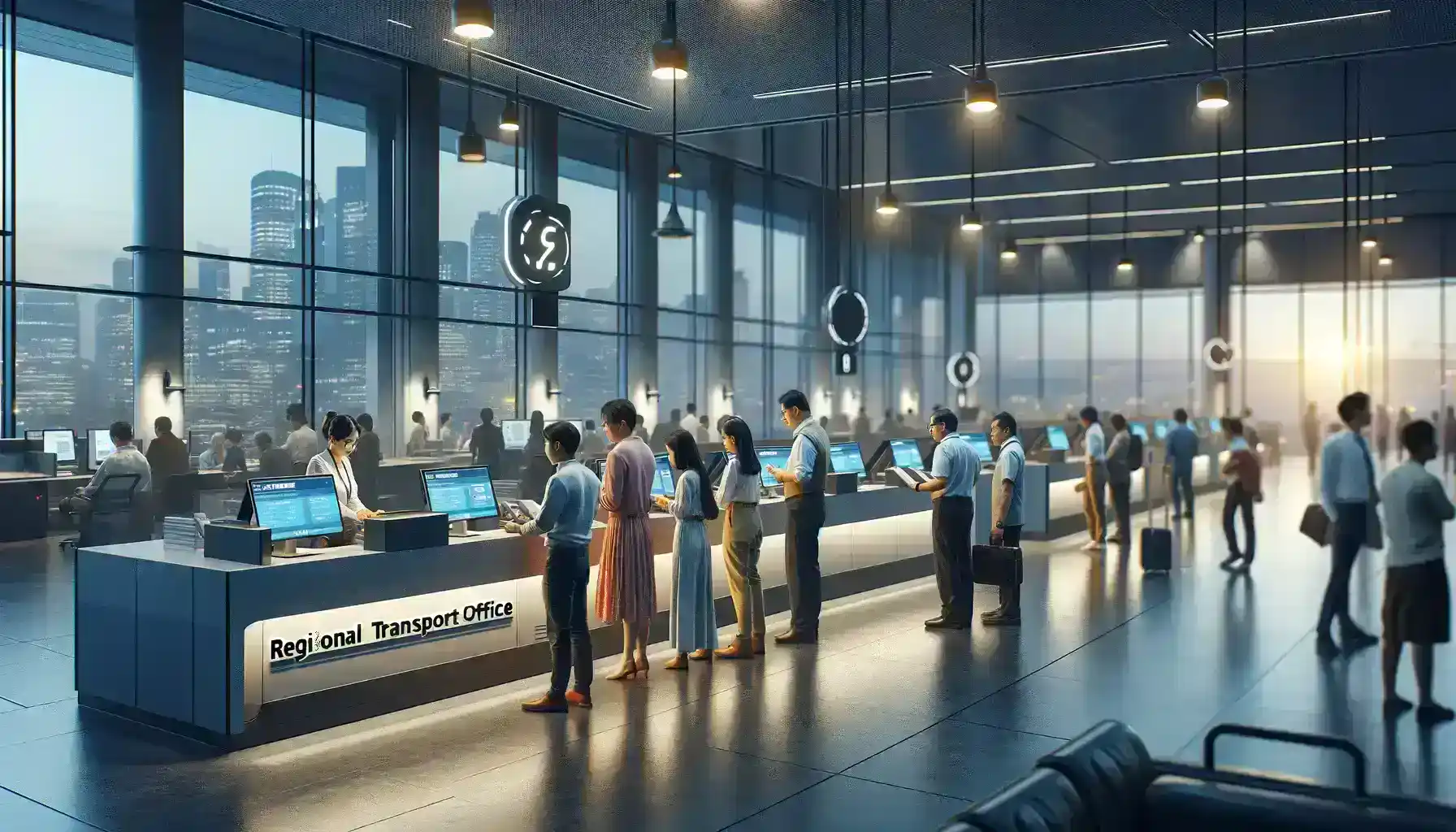Table of Contents
In the context of modernization, transforming RTOs assume a crucial role in overseeing and coordinating the extensive network of vehicles navigating our roadways. The infusion of AI into the core operations of transforming RTOs goes beyond a conventional upgrade; it signifies a revolutionary metamorphosis. This discourse delves into the far-reaching influence of AI in reshaping the functions of RTOs, heralding an era characterized by intelligent efficiency.
This transformation not only optimizes regulatory processes of transforming RTOs but also amplifies the quality of public services rendered. The incorporation of AI, with its capacity for data analysis and automation, marks a paradigm shift that holds the promise of a more streamlined and responsive transportation governance system.

The Imperative for Transforming RTOs
The challenges confronting RTOs are diverse, encompassing manual paperwork, intricate processes, and the escalating volume of vehicles navigating our roads. A transformative solution is imperative to overcome these hurdles. AI emerges as the catalyst essential to propel transforming RTOs into a novel era marked by heightened efficiency, enhanced accuracy, and seamlessly streamlined operations.
This section underscores the compelling necessity and urgency for the profound transformation of RTOs through the strategic integration of AI, recognizing it as the driving force poised to revolutionize the traditional landscape of regulatory bodies responsible for overseeing and managing regional transportation systems.
Streamlining Administrative Processes
The operational challenges faced for transforming RTOs due to the burdensome administrative processes, encompassing paperwork, license processing, and registration tasks, have been significantly alleviated by the transformative impact of AI. Intelligent automation, a key component of AI interventions, has emerged as a pivotal force in reshaping and enhancing these administrative functions. This technology is actively streamlining operations, eradicating manual errors, and accelerating the pace of tasks.
Whether it’s the issuance of licenses or the registration of vehicles, AI has played a crucial role in eliminating bureaucratic bottlenecks that once hindered the efficiency of RTOs. The result is a seamlessly integrated and highly efficient RTO landscape, marking a paradigm shift in the traditional modus operandi towards a more streamlined and technologically advanced system, truly transforming RTOs into adaptive, responsive entities.
A transformative AI tool often utilized for streamlining administrative processes in RTOs is a Robotic Process Automation (RPA) system. RPA deploys software robots or “bots” to automate repetitive and rule-based tasks within administrative workflows.
Specifically applied in the context of RTOs, RPA accelerates tasks like data entry, document verification, and routine paperwork, significantly reducing the workload on human resources while minimizing errors. This transformative tool facilitates efficiency by swiftly managing time-consuming tasks, enabling RTO staff to prioritize more complex and strategic aspects of their responsibilities, thereby transforming RTOs into more agile and effective entities.
Digital Transformation of Licensing Procedures
The integration of AI in RTOs is notably transformative through the digitization of licensing procedures. This departure from traditional methods eradicates lengthy queues and intricate paperwork associated with license applications. AI-driven systems streamline the entire process by enabling online applications, automating document verification, and even conducting online tests.
This digitized approach not only accelerates the application process for applicants but also ensures a precise evaluation of driving skills, thereby significantly contributing to the enhancement of road safety standards. The infusion of AI technology in licensing procedures marks a pivotal shift in RTO operations, fostering efficiency, accuracy, and a more contemporary experience for individuals seeking licensing services.
An AI tool, crucial for transforming RTOs, is the “AI-powered License Management System” or an “Automated License Processing System.” These systems utilize AI to streamline and digitize the entire licensing process, handling online applications, document verification, and even conducting online tests for driving skills.
The AI algorithms within these transformative tools are designed to enhance accuracy, speed up the application process, and provide a more efficient and user-friendly experience for both applicants and regulatory authorities. Such tools significantly contribute to transforming RTOs, making the licensing procedures more accessible and technologically advanced.
Intelligent Traffic Management
AI’s transformative impact on RTOs is particularly evident in the realm of traffic management, a pivotal facet of their functions. Leveraging AI, RTOs deploy smart traffic management systems that go beyond mere regulation. These systems, infused with the analytical capabilities of AI, adeptly process real-time traffic data, predict congestion points, and dynamically optimize traffic signal timings. The result is a significant alleviation of traffic-related challenges, from congestion to delays.

Importantly, this AI-driven efficiency extends its benefits to environmental goals as well. By enhancing the flow of traffic and reducing idle times, these systems contribute directly to lower fuel consumption and diminished emissions, aligning seamlessly with broader environmental sustainability objectives. In essence, the integration of AI is not only streamlining the operational aspects of RTOs but also fostering a positive impact on the ecological footprint of transportation systems, truly transforming the way these offices function.
Transforming RTOs, Smart Traffic Management Systems use AI algorithms to analyze real-time traffic data, predict congestion points, and optimize traffic signal timings. Incorporating advanced sensors, cameras, and machine learning capabilities, they efficiently monitor and manage traffic flow. Processing and interpreting data in real-time, these systems contribute to reducing traffic congestion, improving road safety, and optimizing the overall transportation infrastructure within a region.
Predictive Maintenance for Vehicle Inspections
The integration of AI is significantly transforming the landscape of vehicle inspections within RTOs. AI, through the implementation of predictive maintenance algorithms, enables RTOs to proactively identify potential issues in vehicles well before they reach critical stages. This transformative approach not only enhances road safety by addressing potential safety hazards promptly but also plays a pivotal role in minimizing breakdowns.
The result is a smoother flow of traffic, contributing to overall traffic efficiency and significantly reducing inconvenience for commuters. The predictive capabilities of AI in vehicle inspections mark a paradigm shift in the traditional reactive approach, ensuring that RTOs are at the forefront of promoting safety and optimizing the functionality of vehicles on the road.
One AI tool significantly contributing to transforming RTOs through Predictive Maintenance for Vehicle Inspections is “Cogniac Vehicle Inspection AI.” Cogniac utilizes computer vision and machine learning algorithms to analyze images and data from vehicle inspections. It can predict potential maintenance issues by identifying anomalies or irregularities in vehicle components, such as engine parts, brakes, and tires.
By employing predictive analytics, this AI tool helps RTOs proactively address maintenance needs, reducing the likelihood of breakdowns, enhancing road safety, and ensuring a smoother flow of traffic.
Enhanced Security through AI Surveillance
Transforming RTOs involves a fundamental commitment to public safety, a responsibility that is paramount in the operations of Regional Transport Offices. AI-powered surveillance systems play a pivotal role in adopting a proactive security approach. Utilizing advanced cameras with facial recognition and anomaly detection capabilities, these systems significantly enhance the identification process, targeting stolen vehicles, wanted individuals, and suspicious activities.
The integration of such technology fortifies the overall security framework within the region, thereby contributing to the establishment of a safer and more secure transportation environment. This transformation ensures that RTOs not only adhere to regulatory functions but actively utilize cutting-edge technology to elevate the safety standards of the entire transportation ecosystem.
Facial Recognition Systems, a vital AI tool for transforming RTOs, employ algorithms to analyze and identify individuals based on facial features captured by surveillance cameras. In regional transport offices, these systems enhance security by monitoring entry points, identifying unauthorized access, and assisting in the recognition of individuals involved in suspicious or criminal activities.
The use of facial recognition technology contributes to a more proactive and efficient security framework, thereby bolstering the overall safety and surveillance capabilities of transforming RTOs.
Data-Driven Decision-Making in RTOs
The infusion of AI into the operations of RTOs heralds a transformative era by providing a substantial reservoir of data for informed decision-making. With AI analytics at their disposal, RTOs can delve deep into intricate details such as traffic patterns, accident hotspots, and compliance rates.
This wealth of data-driven insights empowers regulatory authorities to implement precision-targeted interventions, allocate resources with heightened efficiency, and embark on a continual journey of improving the overall effectiveness of their regulatory measures. The capacity to extract meaningful information from the data spectrum not only enhances the proactive nature of RTO initiatives but also ensures a more responsive, adaptive, and strategically aligned approach in the management and regulation of transportation systems.
In essence, the integration of AI is not just a technological upgrade; it is a catalyst for the dynamic transformation of RTOs into agile and data-savvy entities at the forefront of regulatory excellence.
A Predictive Analytics Platform, commonly utilized in transforming RTOs, employs advanced algorithms to analyze historical and real-time data in RTOs. By processing traffic patterns, accident occurrences, compliance rates, and other factors, this tool identifies trends, forecasts potential issues, and provides insights for informed decision-making.
This aids authorities in optimizing resource allocation, implementing targeted interventions, and continuously improving the effectiveness of regulatory measures, all rooted in a data-driven understanding of the transportation landscape.
Improved Customer Services
The pivotal shift toward becoming service-oriented entities for the public, transforming RTOs goes beyond their conventional regulatory role. AI plays a transformative role in enhancing customer service within these offices. Through the implementation of AI-powered chatbots equipped with natural language processing capabilities, RTOs can offer instant and accurate responses to inquiries, guide applicants seamlessly through complex processes, and provide personalized assistance.
This integration of AI not only streamlines interactions but significantly contributes to heightened customer satisfaction, marking a crucial aspect of the overall transformation that these offices are undergoing. The automation of customer service processes enables RTOs to cater to the public’s needs more efficiently.

A transformative AI tool in RTOs is the Chatbot System, integral for improved customer services. Powered by AI and natural language processing, these chatbots interact with individuals, addressing inquiries about license procedures, vehicle registration, and related services.
They provide instant responses, guide users through processes, and offer personalized assistance, thus significantly enhancing the overall customer experience. In addition to improving efficiency by handling routine queries, chatbots play a crucial role in transforming RTOs by freeing up human resources for more complex tasks and ensuring individuals interacting with the transport office receive prompt and accurate information.
Training and Skill Development
The integration of AI-driven simulators is transforming RTOs, effecting a revolutionary change in driver training. These simulators, leveraging AI, reshape the RTO landscape by immersing aspiring drivers in virtual reality simulations. In this controlled environment, individuals gain hands-on experience in navigating real-world scenarios, thereby refining their skills and honing decision-making abilities.
This transformative approach not only contributes significantly to the overarching goal of safer roads but also ensures that drivers undergo comprehensive training, becoming well-prepared to handle a diverse range of situations they may encounter on the roads. This innovative use of AI in driver training marks a crucial step in the broader process of transforming RTOs, fostering a more effective and adaptive approach to ensuring the competency and preparedness of drivers within the transportation ecosystem.
A transformative AI tool for skill development in RTOs is the Virtual Reality (VR) Driving Simulator. Utilizing AI algorithms, these simulators create realistic driving scenarios in a controlled virtual environment. Aspiring drivers engage with diverse situations, including varied road conditions, traffic scenarios, and challenging maneuvers.
The AI component enhances the experience by adapting scenarios based on the driver’s actions, offering real-time feedback, and assessing decision-making skills. VR driving simulators, thus, play a pivotal role in transforming RTOs by contributing to safer and more effective driver training, allowing for the assessment and enhancement of skills in a controlled and risk-free environment.
Future Prospects and Adaptability
In tandem with technological advancements, the future of AI in RTOs holds immense potential for transformative evolution. The article anticipates a trajectory where connected vehicles seamlessly integrate into the regulatory framework, heralding a new era of intelligent transportation. The prospect of further automation within RTO processes emerges as a cornerstone, promising heightened efficiency and reduced manual intervention.

As AI algorithms continue to evolve, RTOs stand at the forefront of adapting to these advancements, shaping a landscape where predictive analytics and machine learning redefine how regulations are enforced and traffic is managed. The adaptability of RTOs to embrace these emerging technologies becomes paramount, ensuring a dynamic and future-ready transportation ecosystem that not only keeps pace with technological shifts but leverages them to enhance overall effectiveness and responsiveness.
Conclusion
“AI Empowerment 360: Transforming Regional Transport Offices with Intelligent Efficiency” captures the profound shift occurring in the functioning of RTOs. Through AI integration, these regulatory bodies are not merely modernizing but actively transforming into intelligent and responsive entities. From streamlined administrative processes to enhanced security and improved customer services, AI is the driving force behind a more efficient, safer, and technologically advanced transportation ecosystem, thereby transforming RTOs. As RTOs continue to embrace AI empowerment, the journey towards a seamlessly connected and intelligently managed transportation future gains momentum.